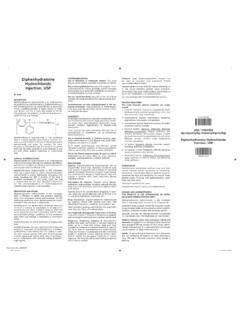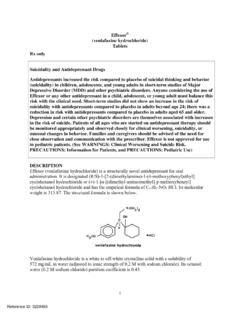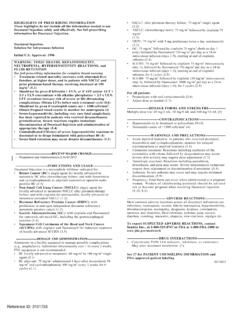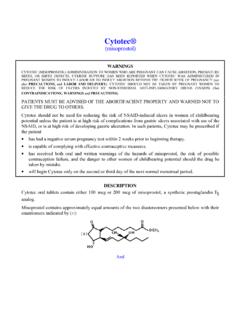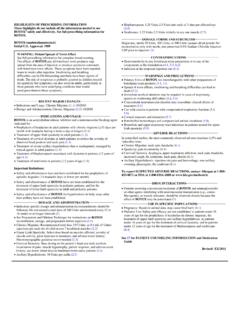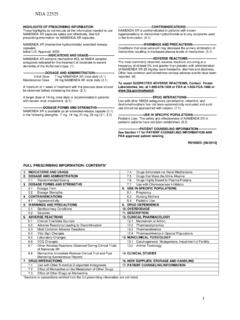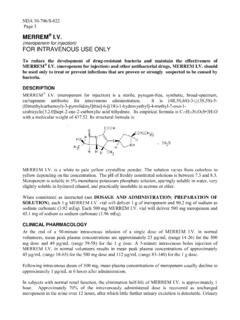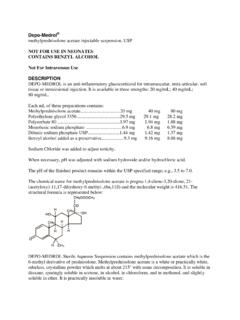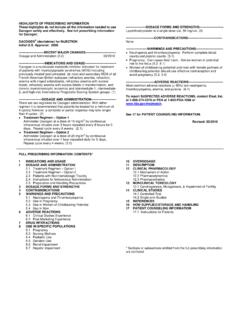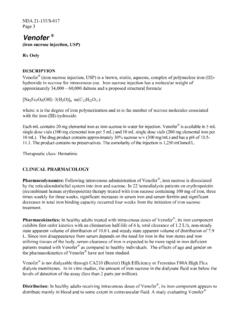Transcription of DIANEAL Peritoneal Dialysis Solution - Food and Drug ...
1 DIANEAL Peritoneal Dialysis Solution For intraperitoneal administration only DIANEAL PD-2 Peritoneal Dialysis Solution With Dextrose DIANEAL PD-2 Peritoneal Dialysis Solution With Dextrose DIANEAL PD-2 Peritoneal Dialysis Solution With Dextrose DIANEAL Low calcium ( mEq/L) Peritoneal Dialysis Solution With Dextrose DIANEAL Low calcium ( mEq/L) Peritoneal Dialysis Solution With Dextrose DIANEAL Low calcium ( mEq/L) Peritoneal Dialysis Solution With Dextrose DESCRIPTION DIANEAL Peritoneal Dialysis solutions are sterile, nonpyrogenic solutions in flexible containers for intraperitoneal administration only.
2 The Peritoneal Dialysis solutions contain no bacteriostatic or antimicrobial agents. Composition, calculated osmolarity, pH, and ionic concentrations are shown in Tables 1-6. DIANEAL is a hyperosmolar Solution . The plastic container is fabricated from polyvinyl chloride (PL 146 Plastic). Exposure to temperatures above 25 C/77 F during transport and storage will lead to minor losses in moisture content. Higher temperatures lead to greater losses. It is unlikely that these minor losses will lead to clinically significant changes within the expiration period. The amount of water that can permeate from inside the Solution container into the overwrap is insufficient to affect the Solution significantly.
3 solutions in contact with the plastic container can leach out certain of its chemical components in very small amounts within the expiration period, di-2-ethylhexyl phthalate (DEHP), up to 5 parts per million; however, the safety of the plastic has been confirmed in tests in animals according to USP biological tests for plastic containers as well as by cell culture toxicity studies. CLINICAL PHARMACOLOGY Mechanism of Action DIANEAL is a hypertonic Peritoneal Dialysis Solution containing dextrose, a monosaccharide, as the primary osmotic agent. An osmotic gradient must be created between the Peritoneal membrane and the Dialysis Solution in order for ultrafiltration to occur. The hypertonic concentration of glucose in DIANEAL exerts an osmotic pressure across the Peritoneal membrane resulting in transcapillary ultrafiltration.
4 Like other Peritoneal Dialysis solutions , DIANEAL contains electrolytes to facilitate the correction of electrolyte abnormalities. DIANEAL contains a buffer, lactate, to help normalize acid-base abnormalities. Pharmacokinetics of DIANEAL Glucose content in DIANEAL is expressed as dextrose monohydrate and is available in three concentrations: , and Reference ID: 3814105 Glucose is rapidly absorbed from the Peritoneal cavity by diffusion and appears quickly in the circulation due to the high glucose concentration gradient between DIANEAL compared to blood capillary glucose level.
5 Absorption per unit time will be the highest at the start of an exchange and decreases over time. The rate of glucose absorption will be dependent upon the transport characteristics of the patient s Peritoneal membrane as determined by a Peritoneal equilibration test (PET). Glucose absorption will also depend upon the concentration of glucose used for the exchange and the length of the dwell. Glucose is metabolized by normal cellular pathways ( glycolysis) and provides a source of calories and may elevate blood glucose levels. Transport of other molecules across the Peritoneal membrane, such as lactate, will occur by diffusion. Metabolism of lactate occurs in the liver and results in the generation of the bicarbonate.
6 Transport of other molecules will be dependent upon the molecular size of the solute, the concentration gradient, and the effective Peritoneal surface area as determined by the PET. INDICATIONS AND USAGE DIANEAL Peritoneal Dialysis solutions are indicated for patients in acute or chronic renal failure when nondialytic medical therapy is judged to be inadequate. CONTRAINDICATIONS DIANEAL is contraindicated in patients with pre-existing severe lactic acidosis. WARNINGS Encapsulating Peritoneal Sclerosis (EPS) is considered to be a known, rare complication of Peritoneal Dialysis therapy. EPS has been reported in patients using Peritoneal Dialysis solutions including DIANEAL . Infrequently, fatal outcomes of EPS have been reported with DIANEAL .
7 Because DIANEAL is a dextrose-based Solution , patients with allergy to corn or corn products are at increased risk for allergic reaction, which may include anaphylactic/anaphylactoid reactions. Stop the infusion immediately, drain the Solution from the Peritoneal cavity and treat appropriately if any signs or symptoms of a suspected hypersensitivity reaction develop. Patients with severe lactic acidosis should not be treated with lactate-based Peritoneal Dialysis solutions (See Contraindications). Patients with conditions known to increase the risk of lactic acidosis [ , severe hypotension or sepsis that can be associated with acute renal failure, hepatic failure, inborn errors of metabolism, and treatment with drugs such as nucleoside/nucleotide reverse transcriptase inhibitors (NRTIs)] must be monitored for the occurrence of lactic acidosis before the start of treatment and during treatment with lactate-based Peritoneal Dialysis solutions .
8 When prescribing the Solution to be used for an individual patient, consideration should be given to the potential interaction between the Dialysis treatment and therapy directed at other existing illnesses. Serum potassium levels should be monitored carefully in patients treated with cardiac glycosides. For example, rapid potassium removal may create arrhythmias in cardiac patients using digitalis or similar drugs; digitalis toxicity may be masked by hyperkalemia, hypermagnesemia, or hypocalcemia. Correction of electrolytes by Dialysis may precipitate signs and symptoms of digitalis excess. Conversely, toxicity may occur at suboptimal dosages of digitalis if potassium is low or calcium is high.
9 Diabetics require careful monitoring of insulin requirements and other treatments for hyperglycemia during and following Dialysis with dextrose containing solutions . Reference ID: 3814105 PRECAUTIONS General Peritoneal - Dialysis Related DIANEAL is intended for intraperitoneal administration only. Not for intravenous administration. The following conditions may predispose to adverse reactions to Peritoneal Dialysis procedures: abdominal conditions, including uncorrectable mechanical defects that prevent effective Peritoneal Dialysis or increase the risk of infection, disruption of the Peritoneal membrane and diaphragm by surgery, congenital anomalies or trauma prior to complete healing, abdominal tumors, abdominal wall infections, hernias, fecal fistula, colostomies or ileostomies, frequent episodes of diverticulitis, inflammatory or ischemic bowel disease, large polycystic kidneys, or other conditions that compromise the integrity of the abdominal wall, abdominal surface, or intra-abdominal cavity.
10 Such as documented loss of Peritoneal function or extensive adhesions that compromise Peritoneal function. Conditions that preclude normal nutrition, impaired respiratory function, recent aortic graft placement, and potassium deficiency may also predispose to complications of Peritoneal Dialysis . Aseptic technique must be employed throughout the Peritoneal Dialysis procedure to reduce the possibility of infection. Following use, the drained fluid should be inspected for the presence of fibrin or cloudiness, which may indicate the presence of peritonitis. If peritonitis occurs, the choice and dosage of antibiotics should be based upon the results of identification and sensitivity studies of the isolated organism(s) when possible.
